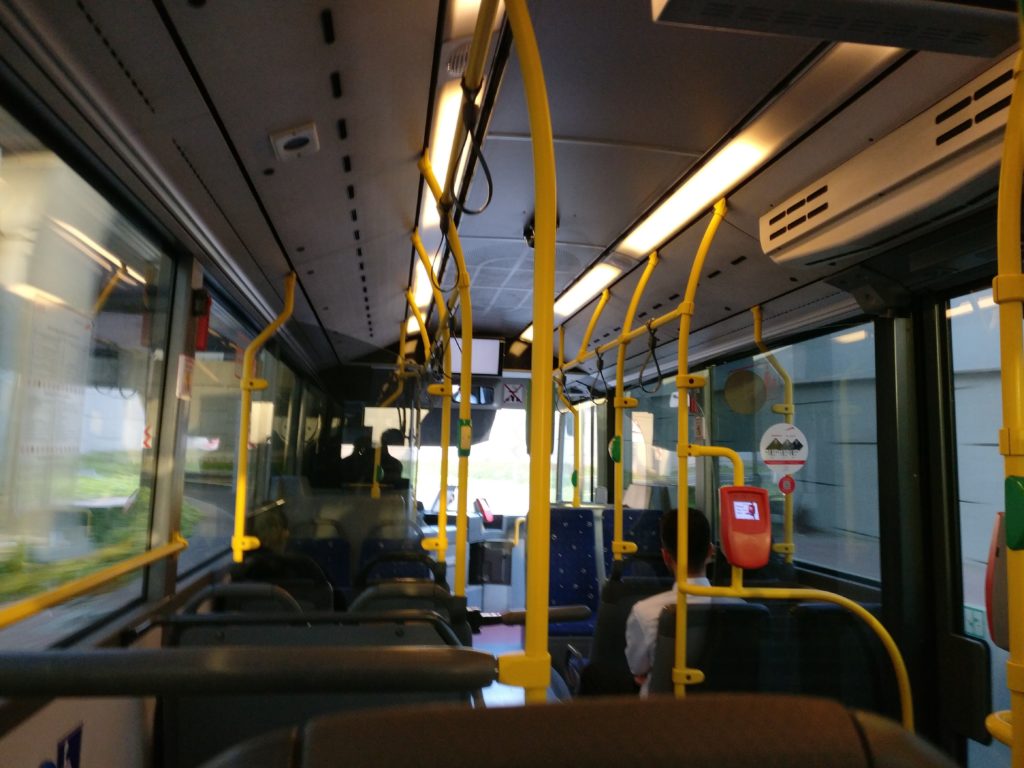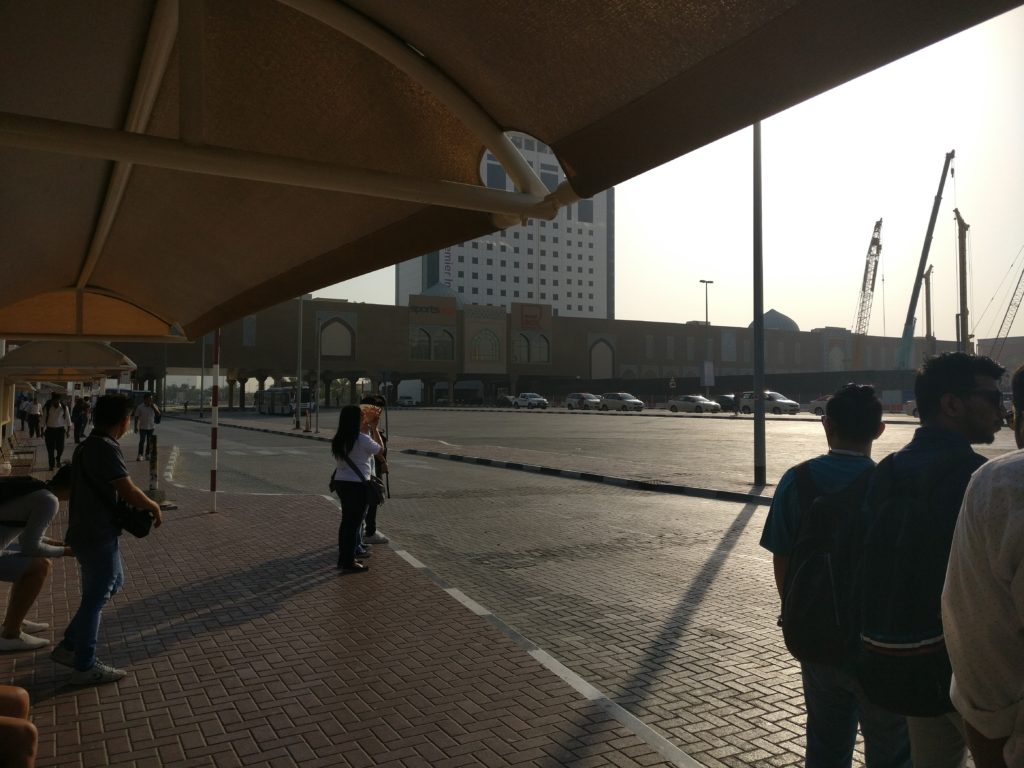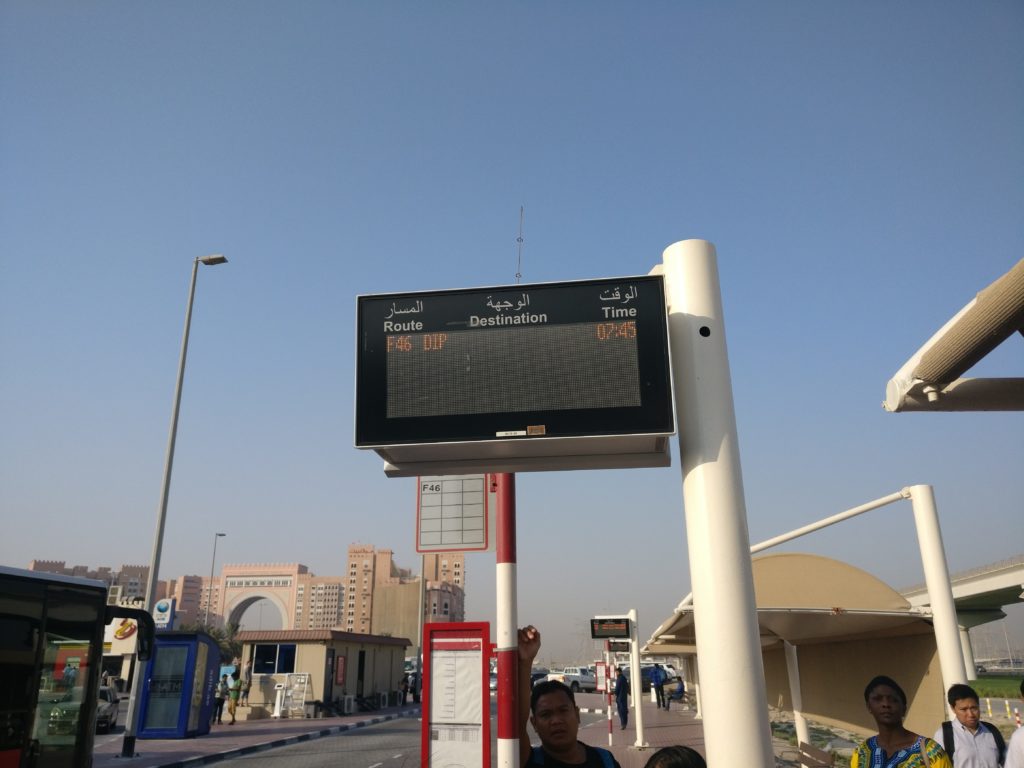Experience: First Public Transport Commute in Dubai
Mirdif to Rashidiya Metro Station
So thanks to the Wojhati app (Google Play | App Store), I was able to plan my departure. According to the information received, if I left my house at 6:23 am, I should make my way to the nearest bus stop and catch the 6:29 to the Rashidiya Metro Station. Since I like arriving early, I left home at 6:15 am and got to the bus stop in 5 minutes. Luck would have it; this Dubai morning was quite humid – sweat dripping from your forehead humid. I barely made it a few meters from my home, and I was a sweaty mess. Adding to my early morning woes, the RTA’s air-conditioned bus stop was not functioning (I don’t think it has been since the world economy imploded in 2008). So I waited till about 6:25 am when two buses approached. One was heading to Etisalat Metro Station and the other to Rashidiya Metro. Strangely enough, the one heading to Rashidiya Metro arrived early as it was supposed to come at 6:40 am. If I followed Wojhati, another bus line would have taken me to the Rashidya Metro Station at 6:29 am. That is why it’s important to get early to the bus stop and check the schedule board to identify alternative buses that can be used – thus saving you the need to sweat for no reason.
The bus ride was uneventful. There were only three other passengers and one stop before reaching our destination. One traveller was staring out the large tinted windows; another was reading on his phone while a women seemed to be resting her head on the headrest in front (important to mention that sleeping on Dubai public transport is illegal). We all got off at the final stop (Rashidiya Metro Bus Parking Lot) and snaked our way through the myriad of escalators to the Rashidiya platform.

Morning Ride on Dubai Bus
Metro Ride to Ibn Battuta
It was going to be an hour ride on the Red Line to Ibn Battuta Metro Station. The platform at Rashidiya was busy but not overwhelming. With the morning rush hour in effect, trains are regularly available with the need to wait only a moment before the next train appeared on the platform. The benefit of hopping on the metro at its end points is that you greeted by an empty car so getting a seat for the long commute is achievable. Again, the ride was quite empty as we hit the next few stops. The cars started to fill up when we stopped at Riqqa; this is where people started to pour in. An expected outcome as Riqqa is practically the centre of old Dubai and the station allows commuters to switch between the two Metro lines.
Seating is sparse on the cars, so the majority of passengers will stand – which is where the benefit of joining the ride at the starting point comes into play. I do tend to feel conscious that there is a crowd of standing people hovering around you as you sit comfortably but I guess that is a feeling any public transport commuter would feel and may become less of an issue as the frequency of use increases.
At 7:10 am, I am at Business Bay and although the cars are full it’s not suffocating. Everyone has sufficient amount of personal space around them (as sufficient as you can expect on public transport). The worst I’ve seen it was at Dubai World Trade Center station at the end of a major exhibition in 2015. It was sardine-like in the cars and although there was a train every 3 minutes, they were absolutely full with people having to literally squeeze in. It was horrifying and I simply walked out of the station and had my wife pick me up. That is my only fear with this commute which I might face on the ride home tonight since I will be joining the Metro well into its ride from Jebel Ali.
As the journey progressed, the cars never really filled to their fullest and at the Dubai Internet City stop, the train emptied out. I suppose with most malls closed till 10; my early morning commute beat the retail employee rush that you would expect.
To be honest, I found the commute productive. For instance, I am typing this blog post as I ride. When you drive, you focus solely on the road, and after doing it day in and out for 12 years, you realise that a significant amount of hours are wasted doing practically nothing. Although the commute is substantially longer (30 minutes by car versus 1h45 by public transport), I think I may have added more productive hours to my day. Let’s see if this positive mindset is still in play after a week of public commuting.
Bus to Dubai Investments Park

Shaded Bus Stop outside Ibn Battuta Metro Station
Luckily, the bus stop at Ibn Battuta is shaded thus providing relief from the rising sun. Somehow it seems that the humidity has eased so the wait for the 7:45 am bus was not bad, except that it didn’t arrive on time (about 3 minutes late). There was a significant crowd waiting but this route uses an elongated bus so everyone was able to board. However, according to the Wojhati app, I was going to be late for work. I may need to take the earlier bus out of Mirdif it seems.

Electronic Bus Signboard at Ibn Battuta
No seats were available on the bus as I am not the type who will push their way to the front of the line entering the bus to get a seat. One thing I did notice though was that the bus was LOUD. The engine/road noise was deafening. The road to DIP is highway traffic so I guess these buses are designed for city roads where high speeds are unwarranted. But on Sh. Zayed Road and Al Yalais Road, the engines seemed continuously revved – I couldn’t make out the song that was playing through ear buds.
I finally reached my bus stop, got off and made the 5-minute walk to the office. Overall a pleasant commute except that I am about 10 minutes late.
Heading Home: Bus Ride from Office to Ibn Battuta Metro Station
So it’s the end of the workday, and I am trying the commute home. There’s a bus stop outside the office, so the walk is more manageable in the 5:00 pm heat. As I got to the stop, a bus was approaching. However, I should have had a better look at the number. It said F47, but according to the Wojhati app, I was supposed to get on F46. Now the sign did say Ibn Battuta MS which I hope I didn’t misread however I am not too concerned yet. The road seems correct and the ‘F’ in the call number on the bus means it’s a feeder bus to and from the Metro and the bus is blue which is another visual confirmation that it’s a feeder route (in comparison to the red buses). Practically every seat on the bus was taken, and my stop was one of the final ones (if I am heading in the direction I believe it should be heading toward). So far, the entire ride seems doable. My biggest fear is yet to come – the evening ride on the Metro. I am hoping that since the station is near the start, it may not be too full. Fingers crossed ?.
Metro Ride Home
As expected, the carriage was full regarding seats. No one was standing, so that is a plus though I expect that to change substantially. The crowds continued to grow as we hit each stop with things getting tight at Noor Bank Metro Station. That is only nine stops into my 28 stop path home. Most passengers will most likely get off at the upcoming interchange stations and the old Deira districts. However, there is still the Dubai Mall and World Trade Center riders to contend with. But I spoke too soon: the sardine level of the Metro ride was achieved at Business Bay. I stationed myself near the exit, but the cars are getting claustrophobic. This is starting to remind me of the Japanese metro as people are pushed in with the help of officials. It’s not that bad yet, but I believe it will get there very soon.
At Emirates Towers, we lost what little personal space we had. It has become beyond uncomfortable. And yet people will continue to push their way in. To be honest, I understand their need. They need to get somewhere (probably home) and the metro is the most cost effective method to achieve it. If they wait for an empty train, they might need to wait for hours. I believe this is an issue, but I don’t see a simple solution. At this time of the day, trains are running on tight schedules with a train arriving every few minutes. Can additional trains be added? Not sure.
As expected, things eased at the first interchange station (Burjaman), personal space regained. The carriages are still full, but people are not rubbing against each other. At the next station (Union), it was like magic. The entire car practically emptied out. We are back to the numbers we had when I first joined the Metro at Ibn Battuta. The rest of the ride should be uneventful.
Update: Using Gold Class
A few days ago I decided to try out the Gold Class section of the Dubai Metro for the commute home as a solution to avoid the tight ride from the office back home. The Gold Class section is a single car (either at the beginning or end of the training depending on the direction it is travelling) that consists of plushier seats with some having foldable tables meant for working with laptops. The price difference between the standard class and gold is double. So you pay the price of two standard tickets for the extra space.
When I got on board the gold class section I was greeted by an inspector. I have read about these inspectors but have never seen one on the metro before. He was checking to see if you actually paid for Gold Class. The problem with the Gold Class is that the pay point is in the same location as the standard ticket so technically you can pay with your Silver Nol card and sit in Gold Class. To prevent this misuse, inspectors are occasionally available to check your Gold Nol card to see if it has been recently used. Surprisingly, there were two computers who were sitting in Gold Class but had not paid for it. At the next station, they were escorted off by the inspector where I suspect they were fined AED100 for using the wrong class.
As for the ride in Gold Class, it was quieter and even though it did fill up, it never crowded up. There were no seats by the time we reached the heavy traffic stations near Mall of the Emirates so people had to stand but they were able to maintain sufficient personal space. What I did notice with the Gold Class is that it didn’t have ceiling bars to hold on to. Although this is a supposed to be a higher service offering and you would expect few people to use it, it is still a mass transport solution and I would assume such a feature would be a given.
In any case, I believe that when commuting to work via public transport, I will ride the standard Silver Class on my way to work and use the Gold Class on the ride back.
The last leg
Finally made it to Rashidiya Metro Station and now I am waiting for the bus. Apparently, I have three choices when it comes to riding a bus on the last leg of my journey. However, despite this, I am always lost. The bus area is a large hall with numerous doors on each side. Each exit is marked with a route number, but it still gets confusing. For instance, one bus I can take is the 367, yet I can never find the door for it. Plus my luck would have it that I just miss the bus and need to wait 20 minutes for the next one. I was making good time until I hit this portion of the journey.
I ultimately got on the bus I need to and made the short trip back home. The sun had already set so there was no need to contend with the sun as I made my 5-minute walk from the last bus stop to the door of my house.
Would I do it again?
Overall, the commute was quite enjoyable. As I mentioned, I was able to add productive time to my day although I will need to alter my sleep schedule in order to leave the house by 6:00 am. As long as I can keep myself busy, I could definitely put the time to good use. One difficult aspect of using public transportation is not having control over the departure times. Any late arrivals (either by me or the bus/metro) could easily throw your entire commute off target and there is no way to make up the lost time.
However, another important question is the cost. Would I save money by using public transport? Off the bat, I am going to say yes. But do the numbers really add up especially if you drive a fuel-efficient vehicle?
So let’s take a look at it. My commute to and from work totals about 91.6km by car. On average, my car consumes 6.6 litres of fuel for every 100km. Basing it on September 2017 fuel prices in the UAE for Special 95 (AED1.90), fuel costs alone, driving myself to work and back costs AED11.49. With public transport (on a Nol Silver card), the cost is AED15.00. So public transport is actually more expensive however my calculation fails to consider additional automotive expenses such as wear-and-tear, maintenance costs, and depreciation. Additionally, come January 2018, fuel prices will rise by 5% to account for VAT. Public transport is exempt from VAT.
Despite the lower fuel cost and travel time of using my personal car, I am still heavily considering using public transport. The freedom to have someone else handle the commute while you work on more productive and enjoyable tasks is relieving. As mentioned, I do have to consider the extra commute time (an additional two hours a day) and the importance of the transport system to stick to the schedules set. I might take a hybrid approach where on certain days I use public transport and on others, I take my car.

0 Comments